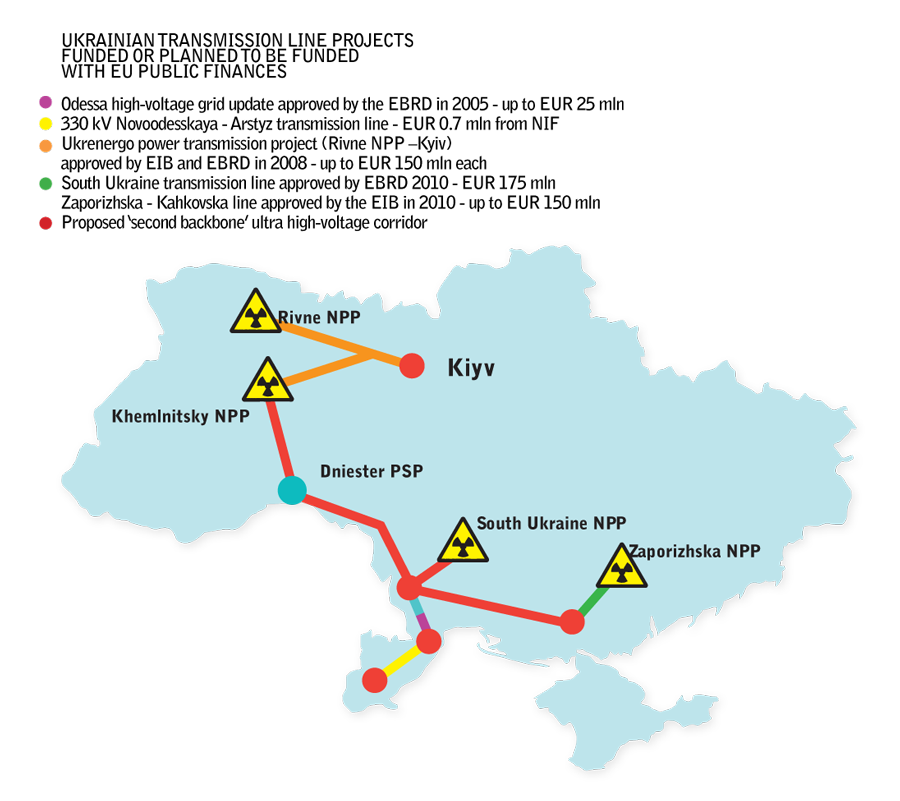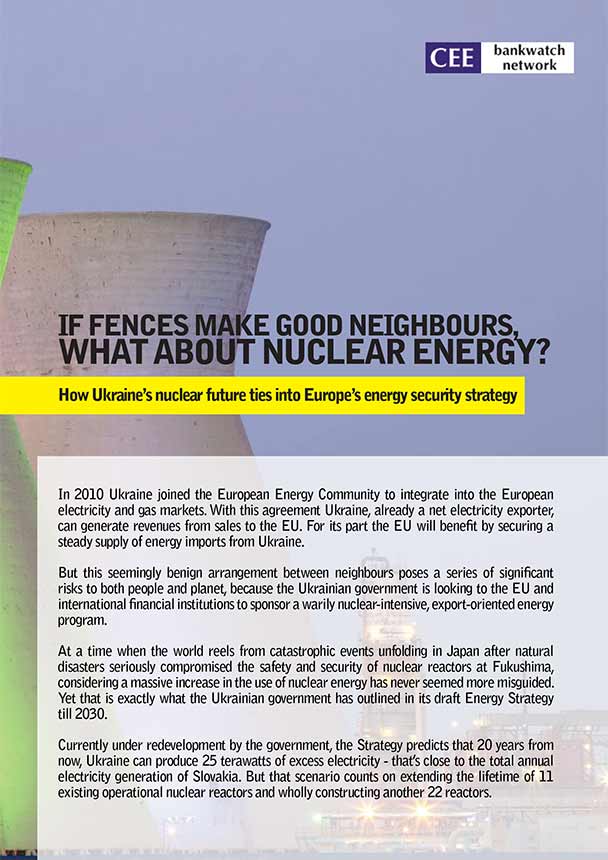The ‘Second Backbone Corridor’ – High voltage electricity transmission lines, Ukraine
In its drive for ‘energy security’, the EU is looking to its eastern neighbour for cheap energy. But using a series of high-voltage transmission lines to import dirty energy supplies like nuclear and coal power from Ukraine will not make the EU safer, and it will lock both into an unstable and environmentally unsound energy mix.
This is an archived project. The information here may be out of date.
Learn more about our current projects and sign up for the latest updates.

Stay informed
We closely follow international public finance and bring critical updates from the ground.
Background
Bankwatch believes that the European Investment Bank (EIB), European Bank for Reconstruction and Development (EBRD) and the EU’s Neighbourhood Investment Facility should not support Ukraine’s aspirations to increase its nuclear programme but rather should help the country make use of its vast energy saving potential and to transform its energy sector.

The Second Backbone Corridor – project brief
The massive Second Backbone Corridor is a series of ultra high voltage electricity transmission lines that are planned to connect 3 Ukrainian nuclear power plants (providing the generation) and two hydro pumped storage plants (PSP) (providing storage).
Stretching the length of Ukraine, the corridor would allow for an increase in the nuclear plants’ output capacity and would lay the technical groundwork to export electricity to EU.
Both the European Investment Bank (EIB) and the European Bank for Reconstruction and Development (EBRD) are and have been involved in several ways:
- Over the last five years they invested approximately EUR 1 billion in the Ukrainian energy sector, mainly in other high voltage transmission lines that would complement the Second Backbone Corridor
- Another export-oriented transmission line – Novoodeska-Artsyz – has been re-launched by the EBRD in November 2010 (after it had been stopped because of the constructor’s plans to cross a Ramsar site).
The short and the long read:
If fences make good neighbours, what about nuclear energy?
Leaflet | 26 April 2011
Ukraine’s energy strategy – the plan behind the electricity transmission lines
By financing the Second Backbone Corridor project, the EBRD and the EIB would be involved in moving Ukraine and Europe further away from a safe and environmentally friendly energy mix. How?
The Second Backbone Corridor is a vital part of Ukraine’s controversial Energy Strategy till 2030.
Currently under redevelopment by the government, the strategy promotes a nuclear-intensive energy programme and includes several other problematic aspects:
- assuming a sharp growth in energy demand (so far, energy consumption in Ukraine is fairly static)
- mostly neglecting energy efficiency measures that would reduce Ukraine’s immense energy intensity (see alternatives below)
- more than doubling the energy production from coal (from 43,5 (2005) to 101 million tons of equivalent fuel (2030)) thus increasing the share of coal in the energy mix from 22% (2005) to 33% (2030) and doubling greenhouse gas emissions
- constructing 22 new nuclear reactors and extending the lifetimes of old reactors currently in operation
(For a detailed criticism of the strategy see the technical analysis (pdf) prepared by Ukrainian NGOs and engineering institutes.)
In short, Ukraine plans to dramatically increase its energy production based on nuclear and coal. The Second Backbone Corridor will be the vehicle bringing this energy to the EU.
Why the EU should not get involved?
Chernobyl and more – nuclear energy in Ukraine is neither safe nor cheap
Nuclear energy and Ukraine are most notoriously synonymous with the meltdown at Chernobyl in 1986. But the nuclear industry is beleaguered by a slew of other dangerous issues:
Disposal of radioactive waste and spent fuel
- The Ukrainian government has made zero investments in infrastructure for the long-term, safe isolation of spent fuel and radioactive waste.
- Under the energy strategy that relies on the Second Backbone Corridor, the total amount of spent nuclear fuel and radioactive waste in Ukraine could increase to 200 million tons annually.
- Neutralization of this hazardous waste could cost exceptional sums – costs which are so far not being mentioned.
Dangerously old nuclear power plants
- The Second Backbone Corridor will connect 12 nuclear reactors, most of which will reach the end of their lifetime by 2020 and are planned for extensions.
- The European Commission and the EBRD are even considering getting factually involved in these extensions with a EUR 800 million loan for the Ukraine NPPs safety upgrade programme. (More information on our website.)
- With every year of operation after a reactor’s lifetime has ended the risk of accidents involving radioactive emissions significantly increases, for instance short circuits or the appearance of cracks in covers of reactor vessels.
Accident at the Rivne NPP – a telling example for the (un)safety of old nuclear reactors
In December 2010, operations at Rivne nuclear power plant’s Reactor 1 were extended for another 20 years in spite of its lifetime having expired. Then just one month later, an accident occurred and the reactor’s output was taken down to 50 percent.
While no radiation leaked in this case, the nuclear industry claims safety as long as no terrible accidents like Fukushima happen. Extending the lifetime of Ukrainian nuclear reactors – some of them from the 1970’s – will create a situation prone to disaster. The EU should not to get involved in such plans and the risks they pose to the Ukrainian people.
Alternatives to nuclear are abundant
Alternatives for investment in the Ukrainian power sector are abundant and promise benefits for people and environment in Ukraine:
- Studies show that energy-saving technologies, coupled with alternative and renewable energy sources, can substitute the nuclear option in developing the Ukrainian power industry. (See for example the alternative energy strategy for Ukraine (pdf))
- In the electricity transmission field the modernisation of local low-voltage grids (between 110 and 330 kV) should be prioritised. Reducing the current power losses of 11 % (twice as much as the EU average) would have the most direct positive effect on people in Ukraine.
- Start-up financing for technical solutions to integrate modern renewable energy sources into the outdated electricity grid can help Ukraine increase its share of renewable energy sources.
Latest news
NECU and Bankwatch statement on the incident at Zaporizhye nuclear plant in Ukraine
Press release | 3 December, 2014Statement on an incident at the Zaporizhye nuclear power plant in Ukraine, where a power transformer dysfunction occurred on November 28th.
Read moreInformation is crucial – Villagers in the way of infrastructure in Ukraine need early support
Blog entry | 15 November, 2013The European Bank for Reconstruction and Development helped solve conflicts between locals and Ukrainian state company Ukrenergo about an EBRD financed transmission line. On close inspection, the case illustrates that without close monitoring and support for local communities, it is left to chance and locals’ dedication that conflicts are being noticed in the first place.
Read moreBogus logic in Ukraine: A nature reserve not worth protecting
Blog entry | 13 February, 2013If you thought the purpose of a nature reserve is to protect wildlife from disruptive human interference, then you’re wrong – at least when it comes to nature that’s in the way of electricity infrastructure in Ukraine.
Read moreRelated publications
Poor quality of draft ESIA report for Part C and D of the 750 kV Rivne – Kyiv High Voltage Line Project
Advocacy letter | 17 October, 2014 | Download PDFLetter to the European Bank for Reconstruction and Development, 17 October 2014 – Download as pdf Letter to the European Investment Bank, 31 October 2014 – Download as pdf
Missing sustainability: The EBRD’s controversial energy lending in Ukraine (2006-2013)
Study | 20 December, 2013 | Download PDFWhile the EBRD’s founding document require it to “promote in the full range of its activities environmentally sound and sustainable development” more than half of the bank’s energy investments in Ukraine for the period 2006-2013 hardly served the purpose of sustainable development promotion. In this period the EBRD has supported nuclear energy production and new output capacities for nuclear power plants, export-oriented infrastructure, as well as controversial initiatives in the renewable energy sector.
Letter to President of Ukraine calling for veto against Khmelnistky nuclear units
Advocacy letter | 20 September, 2012 | Download PDFBankwatch and its members appeal to Viktor Yanukovych, President of Ukraine, to stop the Ukrainian government’s plans to construct two new nuclear units at the Khmelnitsky nuclear power plant. The letter asks Yanukovych to use his vetoing power and not sign the relevant law that was adopted by Ukraine’s parliament on 6 September 2012, since the law is in direct violation of Ukraine’s international obligations.


